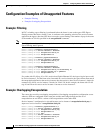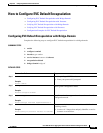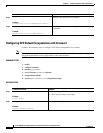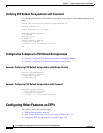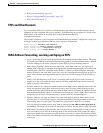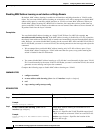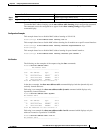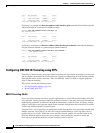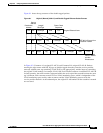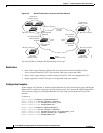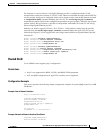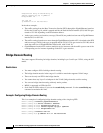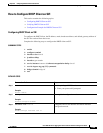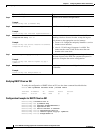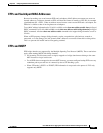
8-20
Cisco ASR 901 Series Aggregation Services Router Software Configuration Guide
OL-23826-09
Chapter 8 Configuring Ethernet Virtual Connections
Configuring Other Features on EFPs
Vlan Mac Address Type Ports
---- ----------- -------- -----
10 0000.0700.0a00 DYNAMIC Gi0/9
10 0000.0700.0b00 DYNAMIC Gi0/1
Total Mac Addresses for this criterion: 2
Following is an example for show mac-address-table interface g0/9 command which displays only the
addresses learned on a particular VLAN/BD interface.
Router# show mac-address-table interface 0/9
Mac Address Table
-------------------------------------------
Vlan Mac Address Type Ports
---- ----------- -------- -----
10 0000.0700.0a00 DYNAMIC Gi0/9
Total Mac Addresses for this criterion: 1
Following is an example for show mac-address-table interface port-channel command which displays
only the addresses learned on a particular port-channel interface.
Router# show mac-address-table interface port-channel 1
Mac Address Table
-------------------------------------------
Vlan Mac Address Type Ports
---- ----------- -------- -----
10 0000.0700.0b00 DYNAMIC Po1
Total Mac Addresses for this criterion: 1
Configuring IEEE 802.1Q Tunneling using EFPs
Tunneling is a feature used by service providers whose networks carry traffic of multiple customers and
who are required to maintain the VLAN and Layer 2 protocol configurations of each customer without
impacting the traffic of other customers. The Cisco ASR 901 router uses EFPs to support QinQ and
Layer 2 protocol tunneling.
This section contains the following topics:
• 802.1Q Tunneling (QinQ), page 8-20
• Routed QinQ, page 8-23
802.1Q Tunneling (QinQ)
Service provider customers often have specific requirements for VLAN IDs and the number of VLANs
to be supported. The VLAN ranges required by different customers in the same service-provider network
might overlap, and traffic of customers through the infrastructure might be mixed. Assigning a unique
range of VLAN IDs to each customer would restrict customer configurations and could easily exceed the
VLAN limit (4096) of the 802.1Q specification.
Using the EVCs, service providers can encapsulate packets that enter the service-provider network with
multiple customer VLAN IDs (C-VLANs) and a single 0x8100 Ethertype VLAN tag with a service
provider VLAN (S-VLAN). Within the service provider network, packets are switched based on the
S-VLAN. When the packets egress the service provider network onto the customer network, the
S-VLAN tag is decapsulated and the original customer packet is restored.



